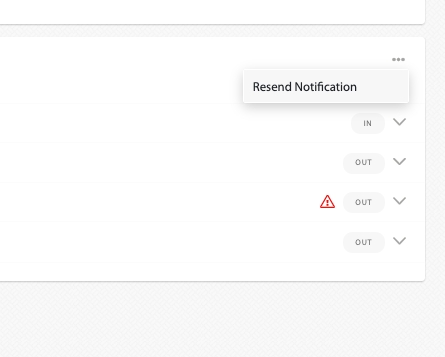Notifications
Every time a cashout changes its status, we will send you an asynchronous notification containing the ID of the cashout by POST protocol in x-www-form-urlencoded format.
The webhooks are sent to:
the
notification_urlyou sent in the request, orto the one you have configured under the section: Settings ➡️ API Access ➡️ Withdrawal URL.
Once received the notification, you should check its new status with the endpoint and update it on your end accordingly.
Firewall configurations
Bear in mind we will only connect through ports 80 and 443.
Make sure your notification_url has one of those ports open accepting connections from us.
Example notification
date=2020-03-12%2020%3A26%3A11
&bank_reference_id=
&comments=
&external_id=cashoutV35381
&control=A4CFF64E78C4BD01F8BFCA4AFF04632EC4A33CC61BD6BBD156BA1289897892EB
&cashout_id=60067
&status_reason=date
Date. Format: YYYY-MM-DD HH:MM:SS (GMT)
Date the cashout changed its status
bank_reference_id
String (max. 50 chars)
Reference ID of the bank if any
comments
String (max. 200 chars)
Comments of the cashout if any
external_id
String (max. 100 chars)
ID of the cashout you sent while creating the request
control
String
Control signature of the notification
cashout_id
Number
ID of the cashout on our end
status_reason
String
Reason of the status if any
Control String
The control string for the notifications is made up of some random characters at the beginning and the end of the request and the external_id received in the middle.
Check the examples below on how to calculate the control string for the notifications:
public static void main(String[] args) throws IOException, NoSuchAlgorithmException, InvalidKeyException {
String external_id = "cashoutID1234";
String message = "Be4" + external_id + "Bo7";
String apiSignature = "your_cashout_api_signature";
Mac hasher = Mac.getInstance("HmacSHA256");
hasher.init(new SecretKeySpec(apiSignature.getBytes(StandardCharsets.UTF_8), "HmacSHA256"));
byte[] result = hasher.doFinal(message.getBytes(StandardCharsets.UTF_8));
System.out.println(StringUtils.upperCase(DatatypeConverter.printHexBinary(result)));
}Testing notification in Staging
Receiving notifications accordingly is part of our integration requirements checklist.
In the Staging environment, in order to test the full flow you can manually set a cashout to COMPLETED, CANCELLED, REJECTED or ON HOLD status by: Logging in into the STG Merchant Panel ➡️ Transactions ➡️ Withdrawals.
Those options will change the status of the deposit, therefore sending the respective notification to your notification_url after a few minutes.

Retry logic
Every time a cashout changes its status, we will send you a notification so you can back.
In case that for some reason your server was unable to receive the notification and you returned an HTTP code different than 2XX, we will retry the notification up to 5 more times or until you respond with HTTP 2XX, whatever comes first.
In case of errors while handling the notification, make sure you will answer with an HTTP code distinct than 2XX, that way we will retry the notification.
The time between the 5 notifications attempts will be of 5 minutes each.
When the notification failed to be sent, it will be shown like this in our Merchant Panel:

If you see the errors from the screenshot above, it means the cashout was successfully completed but suddenly we couldn't notify you. Keep reading to know how to resend the notifications.
Resend Notifications
In case your system was unable to receive the notification in any of the 5 attempts, you can always check its status with the
If you need to trigger the check status by receiving our notification, once the issue preventing you from receiving our notifications was fixed, you can go to the Merchant Panel, locate the cashout (Transactions ➡️ Withdrawals) and click on the three dotted button under the  section and then "Resend notification" to force a new notification to be sent.🕐 It can take up to 2 minutes for the notification to be resent.
section and then "Resend notification" to force a new notification to be sent.🕐 It can take up to 2 minutes for the notification to be resent.

🕐 It can take up to 2 minutes for the notification to be resent.
Last updated
Was this helpful?

